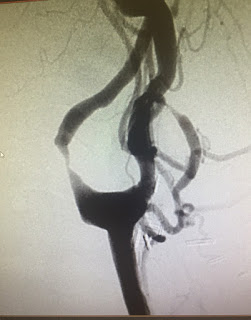Paroxysmal
hypertension can be associated with failure of the carotid artery baroreceptors
due to past exposure to radiation treatment. A case report describes a patient
whose repeated paroxysmal hypertensive episodes were ameliorated following
placement of a carotid artery stent for the treatment of carotid artery
stenosis.
The patient
that was diagnosed with hypopharyngeal squamous cell carcinoma in 2006, and
received 70 Gy intensity-modulated radiotherapy in 2006 and underwent a total
laryngectomy in 2008. He experienced paroxysmal hypertensive episodes since
2010 that exacerbated in frequency in 2019. Eighty percent left internal
carotid artery stenosis was demonstrated by ultrasound and arteriography.
Angioplasty and stenting of the left carotid artery was performed. A Doppler
ultrasound study performed 5 months after the stent placement did not reveal
any hemodynamic stenosis in the left carotid artery. The patient experienced
postprandial hypotension and had experienced only three episodes of paroxysmal
hypertension in the following 24 months. He was able to abort paroxysmal
hypertensive episodes by eating warm food.
This
is the first report of a patient whose paroxysmal hypertensive episodes that
occurred following radiation of the neck subsided after placement of a stent in
a stenotic carotid artery. The exact mechanism leading to this phenomena is
unknown but may be due to several factors. The reversal of the carotid artery
stent and improvement in blood flow to the carotid artery baroceptors may play
a role in this phenomenon. Conclusion: The ability to ameliorate paroxysmal
hypertensive episodes in a patient with carotid artery stenosis by stent
placement may be a promising therapeutic intervention for paroxysmal
hypertension.
Angiogram of the left carotid artery after stenting, no stenosis

